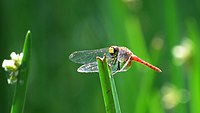| Square-spot basker | |
|---|---|
 | |
| Male Aethriamanta circumsignata, Northern Territory, Australia | |
 | |
| Female Aethriamanta circumsignata | |
| Scientific classification | |
| Domain: | Eukaryota |
| Kingdom: | Animalia |
| Phylum: | Arthropoda |
| Class: | Insecta |
| Order: | Odonata |
| Infraorder: | Anisoptera |
| Family: | Libellulidae |
| Genus: | Aethriamanta |
| Species: | A. circumsignata |
| Binomial name | |
| Aethriamanta circumsignata | |
 | |
Aethriamanta circumsignata known as the square-spot basker [3] is a species of dragonfly in the family Libellulidae. [4] It is found in Australia, and New Guinea. [5] The species is usually found near still or sluggish waters. [3]
Contents
In northern Australia, it is found coastal and adjacent inland in an arc from Broome, Western Australia to around Coffs Harbour in New South Wales. [6]
They are a small dragonfly with a wingspan of 40–60 mm, and predominantly red in colour. The wings have less venation than larger dragonflies, and few antenodal cross-veins. Adults may be found at some distance from water. The hindwing has a brown mark at the base which is squarish in shape, leading to its common name. [3] The taxon has been assessed as being of least concern for the IUCN Red List. [1]





